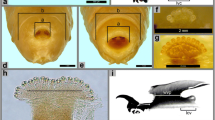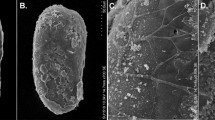Abstract
Piophila Fallén, 1810 is a genus of small flies composed of two species: Piophila casei (P. casei) (Linnaeus, 1758), worldwide distributed, and Piophila megastigmata (P. megastigmata) McAlpine, 1978, recently referred in the Palaearctic Region, from the Iberian Peninsula. Both species share ecological niche and are very interesting for forensic purposes, since they are present in carrion in advance stages of decay and have been found to be related to human corpses. The immature stages of P. megastigmata have ever been described, so this paper gives the ultrastructural morphologies of all preimaginal stages of P. megastigmata studied by light microscopy and scanning electron microscopy (SEM). Particular attention is given to pseudocephalon features—antenna, maxillary palps, facial mask, etc.—cephalopharyngeal skeleton, anterior and posterior spiracles, tegumentary sculpturing, and anal division among others. A comparative analysis of the main distinguishing features is made in order to understand how those features evolve along the developmental process, while larvae II and III are morphologically similar to each other, the larva I shows particular features. Larvae of all stages and pupae are easily distinguishable from other Diptera of forensic importance just based on the presence of trichoid sensilla associated to respiratory slits, instead of peristigmatig tufts, as well as on the well-known disposition of anal papillae. The shapes of both dorsal edge at the basal part of mouthhook and dorsal bridge of cephalopharyngeal skeleton, and the tegumental ornamentation may be considered as good features to distinguish the Piophila species, especially for P. megastigmata and P. casei. At the SEM level, shape, number, and arrangement of oral combs, oral ridges, sensilla of maxillary palpus, papillae of anterior spiracle, scales of spiracular field, and posterior spiracles represent good features to distinguish P. megastigmata from P. casei, but further studies will be necessary in West-Paleartic specimens of latter species. The key for identifying third instar larvae of forensically important Piophilidae in the Iberian Peninsula has been updated to include P. megastigmata.






Similar content being viewed by others
References
Amendt J, Campobasso CP, Gaudry E, Reiter C, LeBlanc HN, Hall MJR (2007) Best practice in forensic entomology—standards and guidelines. Int J Legal Med 121:90–104
Arnaldos MI, Romera E, García MD, Luna A (2001) An initial study on the succession of sarcosaprophagous Diptera (Insecta) on carrion in the southeastern Iberian Peninsula. Int J Legal Med 114:156–162
Byrd JH, Castner JL (2010) Insects of forensic importance. In: Byrd JH, Castner JL (eds) Forensic entomology. The utility of arthropods in legal investigations. CRC, Boca Raton, pp 39–126
Carles-Tolrá M (2012) Segunda cita de Piophila megastigmata McAlpine para España en Aragón (Diptera: Piophilidae). Bol Soc Entomol Aragonesa 50:366
Cogan BH (1973) Cyclorrhapha of minor medical importance. In: Smith KGV (ed) Insect and other arthropods of medical importance. Trustees of the British Museum (Natural History), London, pp 279–287
Courtney GW, Sinclair BJ, Meier R (2000) Morphology and terminology of Diptera larvae. In: Papp L, Darvas B (eds) Contribution to a manual of Paleartic Diptera: general and applied dipterology (Vol 1). Science Herald, Budapest, pp 85–161
Draber-Monko A, Malewski T, Pomorski J, Los M, Slipinski P (2009) On the morphology and mitochondrial DNA barcoding of the flesh fly Sarcophaga (Lyopygia) argyrostoma (Robineau-Desvoidy, 1830) (Diptera: Sarcophagidae)—an important species in forensic entomology. Ann Zool 59(4):465–493
Ebejer MJ (2012) Piophilidae (Diptera) from Gibraltar and the puparium of Piophila megastigmata McAlpine. Dipterists Dig 19:65–71
Erzinçlioglu YZ (1989) The value of chorionic structure and size in the diagnosis of blowfly eggs. Med Vet Entomol 3:281–285
González Medina A, Archilla Peña F, Jiménez Ríos G (2011) Las miasis como entidad de interés en Medicina del Trabajo. Med Seguridad trab (Internet) 57(225):331–338
Grzywacz A, Pape T, Szpila K (2011) Larval morphology of the lesser housefly, Fannia canicularis. Med Vet Entomol 26:70–82
Kitching RL (1976) On the prothoracic spiracles of the first instar larvae of calyptrate Cyclorrhapha (Diptera). J Aust Entomol Soc 15:233
Klong-klaew T, Sukontason K, Sribanditmongkol P, Moophayak K, Sanit S, Sukontason KL (2012) Observations on morphology of immature Lucilia porphyrina (Diptera: Calliphoridae), a fly species of forensic importance. Parasitol Res 111:965–1975
Liu D, Greenberg B (1989) Immature stages of some flies of forensic importance. Ann Entomol Soc Am 82:80–93
Martín-Vega D (2011) Skipping clues: forensic importance of the family Piophilidae. For Sci Int 212:1–5
Martín-Vega D, Gómez-Gómez A, Baz A, Díaz-Aranda LM (2011) New piophilid in town: the first Paleartic record of Piophila megastigmata and its coexistence with Piophila casei in central Spain. Med Vet Entomol 25:64–69
Martín-Vega D, Baz A, Díaz-Aranda LM (2012) The immature stages of the necrophagus fly, Prochyliza nigrimana: comparison with Piophila casei and medicolegal considerations (Diptera: Piophilidae). Parasitol Res 111:1127–1135
McAlpine JF (1978) A new species of Piophila from South Africa (Diptera: Piophilidae). Ann Nat Mus 23(2):455–459
Mendoça PM, Santos-Mallet JR, Mello RP, Gomes L, Carvalho-Queiroz MM (2008) Identification of fly eggs using scanning electron microscopy for forensic investigations. Micronesian 39:802–807
Moophayak K, Sanit S, Sukontason K, Vogtsberger RC, Sukontason KL (2011) Morphological descriptions for the identification of Hypopygiopsis tumrasvini Kurahashi (Diptera: Calliphoridae). Parasitol Res 109:1323–1328
Mote DC (1914) The cheese skipper. (Piophila casei Linné) 1. An account of the bionomics and the structure of dipterous larvae occurring in human foods with particular reference to those which have been recorded as accidental parasites of Man. The Ohio Naturalist, The Biological Club of the Ohio State University Vol. XIV No. 7
Niederegger S, Spieß R (2012) Cuticular muscle attachment sites as a tool for species determination in blowfly larvae. Parasitol Res 110:1903–1909
Niederegger S, Wartenberg N, Spieß R, Mall G (2011) Simple clearing technique as species determination tool in blowfly larvae. For Sci Int 206:e96–e98
Prado e Castro C, García MD (2010) Additions to the Piophilidae (Diptera) fauna from Portugal, with new records. Graellsia 66(1):101–105
Prado e Castro C, Cunha E, Serrano A, García MD (2012) Piophila megastigmata (Diptera: Piophilidae): first records on human corpses. For Sci Int 214:23–26
Sanit S, Sukontason KL, Sribanditmongkol P, Klong-klaew T, Samerjai C, Sontigun N, Limsopatham K, Sukontason K (2012) Surface ultrastructure of larva and puparia of blow fly Hypopygiopsis tumrasvini Kurahashi (Diptera: Calliphoridae). Parasitol Res 111:2235–2240
Simmons P (1927) The cheese skipper as a pest in cured meat. United States Department of Agriculture, Department Bulletin no. 1453. Washington, DC
Siriwattanarungsee S, Sukontason KL, Kuntalue B, Piangjai S, Olson JK, Sukontason K (2005) Morphology of the puparia of the housefly Musca domestica (Diptera: Muscidae) and blowfly, Chrysomya megacephala (Diptera: Calliphoridae). Parasitol Res 96:166–170
Smith KGV (1986) A manual of forensic entomology. Cornell University Press, New York
Sukontason KL, Sukontason K, Piangjai S, Choochote W, Vogtsberger RC, Olson JK (2001) Scanning electron microscopy of the third-instar Piophila casei (Diptera: Piophilidae), a fly species of forensic importance. J Med Entomol 38(5):756–759
Sukontason K, Sukontason KL, Boonchu N, Chaiwong T, Piangjai S (2004) Ultrastructure of eggshell of Chrysomya nigripes Aubertin (Diptera: Calliphoridae). Parasitol Res 93:151–154
Sukontason KL, Sribanditmongkol P, Chaiwong T, Vogtsberger RC, Piangjai T, Sukontason K (2008) Morphology of immature stages of Hemipyrellia ligurriens (Wiedemann) (Diptera: Calliphoridae) for use in forensic entomology applications. Parasitol Res 103:877–887
Sukontason K, Sribanditmongkol P, Ngoen-klan R, Klong-klaew T, Moophayak K, Sukontason KL (2010a) Differentiation between Lucilia cuprina and Hemipyrellia ligurriens (Diptera: Calliphoridae) larvae for use in forensic entomology applications. Parasitol Res 106:641–646
Sukontason K, Bunchu N, Chaiwong T, Moophayak K, Sukontason KL (2010b) Forensically important flesh fly species in Thailand: morphology and developmental rate. Parasitol Res 106:1055–1064
Szpila K, Pape T (2007) Rediscovery, redescription and reclassification of Beludzhia phylloteliptera (Diptera: Sarcophagidae Miltogramminae). Eur J Entomol 104:119–137
Ubero-Pascal N, Fortuño JM, Puig MA (2005) New application of air-drying techniques for studying Ephemeroptera and Plecoptera eggs by scanning electron microscopy. Microsc Res Tech 68:264–271
Ubero-Pascal N, López-Esclapez R, García MD, Arnaldos MI (2012) Morphology of preimaginal stages of Calliphora vicina Robineau-Desvoidy, 1830 (Diptera, Calliphoridae): a comparative study. For Sci Int 219(1):228–243
Velásquez Y, Magaña C, Martínez-Sánchez A, Rojo S (2010) Diptera of forensic importance in the Iberian Peninsula: larval identification key. Med Vet Entomol 24:293–308
Zumpt F (1963) The problem of intestinal myiasis in humans. S Afr Med J 37:305–307
Zumpt F (1965) Myasis in man and animals in the Old World. Butterworths, London
Acknowledgments
This study has been supported by projects 00848/CV/01 of the Fundación Séneca of the Comunidad Autónoma de la Región de Murcia and CGL2005-04668/BOS of Ministerio de Educación y Ciencia of the Spanish Government.
Author information
Authors and Affiliations
Corresponding author
Electronic supplementary material
Below is the link to the electronic supplementary material.
ESM 1
(PDF 2576 kb)
Rights and permissions
About this article
Cite this article
Paños, A., Arnaldos, M.I., García, M.D. et al. Ultrastructure of preimaginal stages of Piophila megastigmata McAlpine, 1978 (Diptera, Piophilidae): a fly of forensic importance. Parasitol Res 112, 3771–3788 (2013). https://doi.org/10.1007/s00436-013-3567-0
Received:
Accepted:
Published:
Issue Date:
DOI: https://doi.org/10.1007/s00436-013-3567-0




